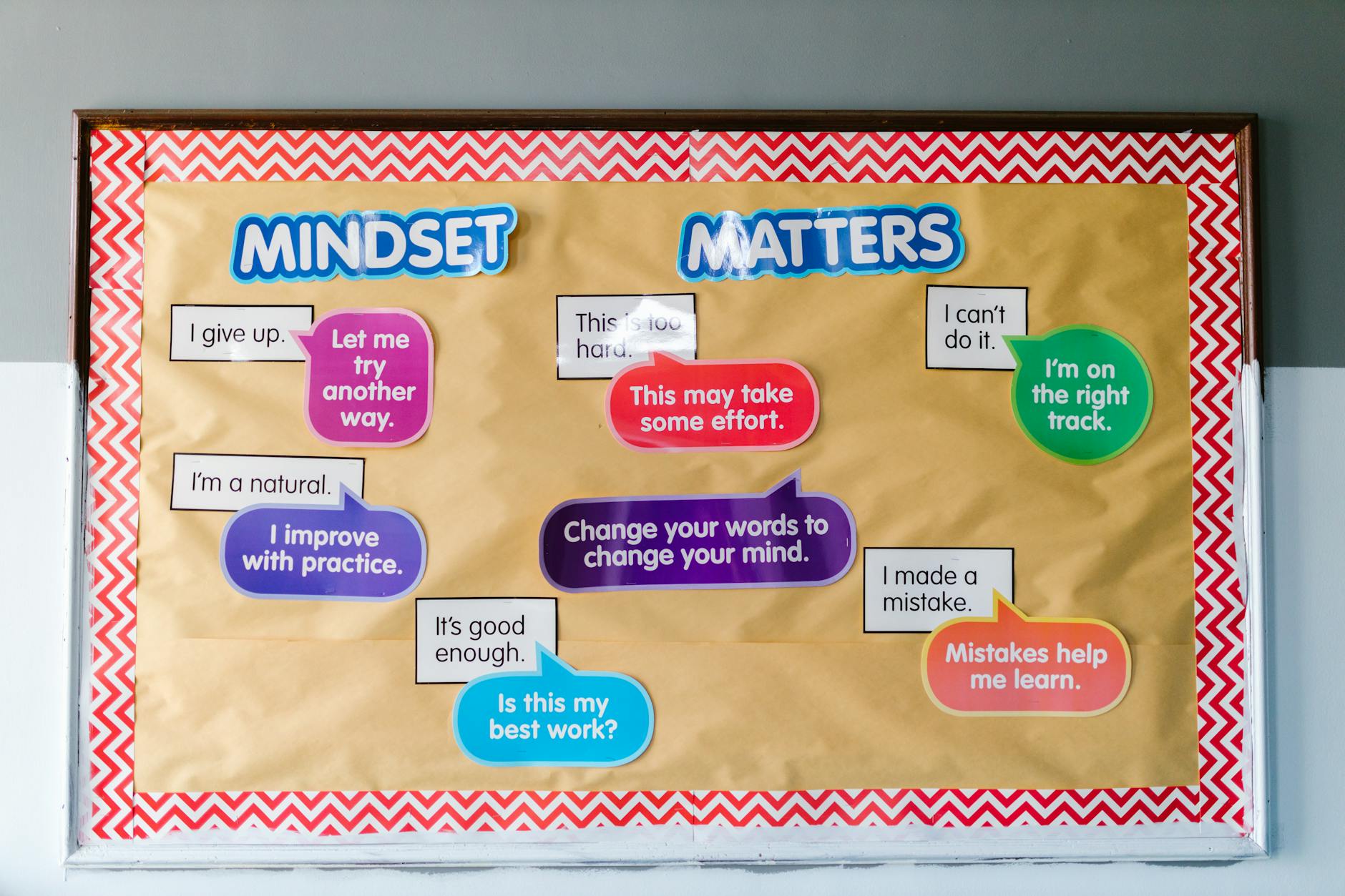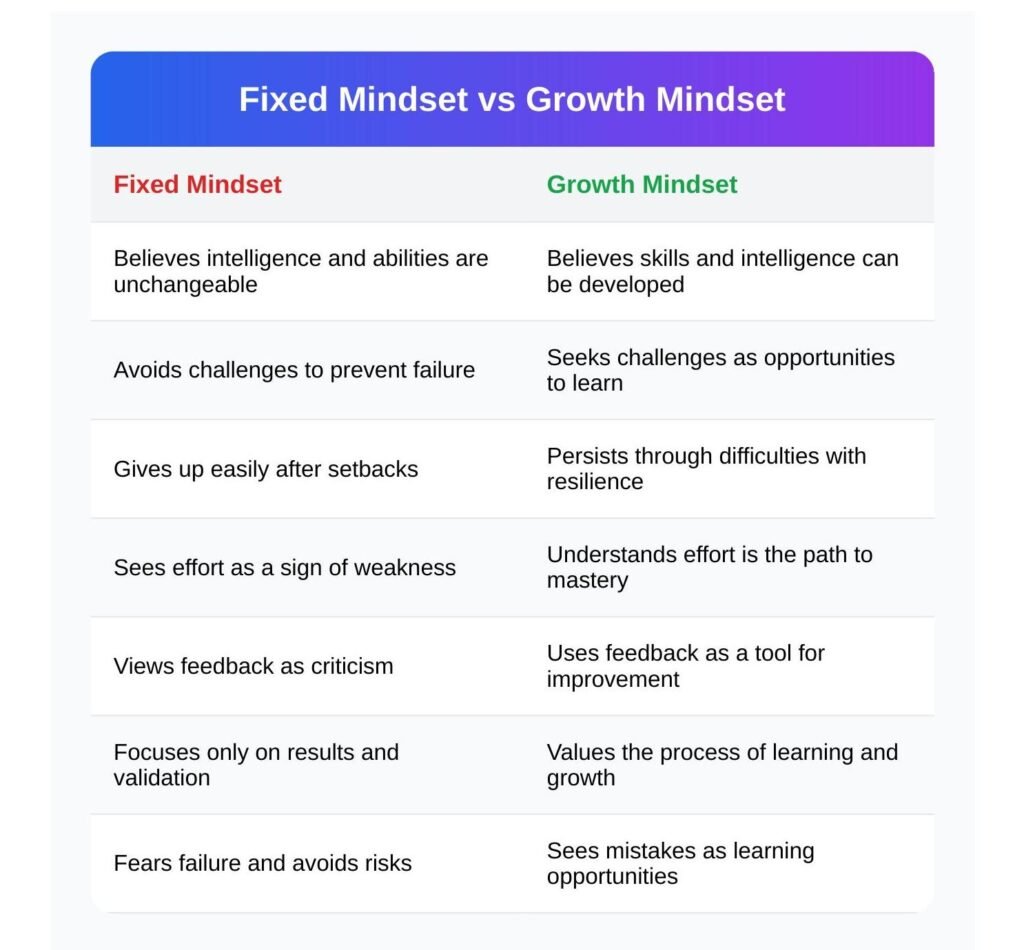“Do you believe intelligence is something you’re born with, or something you can build? The way you answer may predict your future success.”
Mindset significantly influences how individuals approach learning and tackle new challenges. Psychologist Carol Dweck’s decades of research reveal that the key difference lies in whether people view their abilities as fixed traits or capable of development. A fixed mindset believes intelligence and talent are unchangeable fixed traits, while a growth mindset understands that abilities can be improved through effort.
These contrasting beliefs are crucial for anyone focused on personal development. Those with a growth mindset are more likely to demonstrate persistence, stay motivated, and learn from setbacks, leading to stronger performance and lasting progress. Embracing a growth mindset creates a foundation for overcoming challenges and continually expanding your abilities.
What is a Fixed Mindset?
A fixed mindset is the belief that intelligence and abilities are fixed traits that cannot change. This perspective often contrasts with a growth mindset, which values learning and development over time. When you hold a fixed mindset, you tend to avoid risk and challenges, viewing mistakes and failure as proof that your talents are static. Such a mindset can strongly influence your choices, affect your self-esteem, and limit your potential for ongoing learning and improvement.
 Photo by RDNE Stock project
Photo by RDNE Stock project
Core Beliefs of a Fixed Mindset
At the heart of a fixed mindset are several core beliefs:
- Abilities are fixed traits from birth: People with a fixed mindset believe they are born with certain abilities that cannot be changed through effort or practice.
- Effort signals a lack of natural talent: Putting in effort is seen as an admission that you’re not innately capable.
- Results matter more than personal growth: Success is defined by outcomes rather than by the process of learning or self-improvement.
Carol Dweck’s research highlights that those with a fixed mindset frequently tie their self-esteem to how smart they appear or the achievements they accumulate. This mindset can be deeply ingrained and shape many areas of life (Carol Dweck: A Summary of Growth and Fixed Mindsets).
Common Behaviors Linked to a Fixed Mindset
Fixed mindset behaviors often emerge in response to challenges, failure, or feedback. Key signs include:
- Avoiding challenges: The fear of failure discourages trying difficult tasks that could lead to growth.
- Giving up easily: Setbacks are seen as evidence of lacking ability rather than an opportunity to learn.
- Interpreting feedback as a personal attack: Constructive criticism is often rejected because it threatens one’s sense of self.
- Fear of failure: Concern about appearing “not smart enough” stops people from taking risks or exploring new opportunities.
Additionally, a fixed mindset can lead to constant comparison with others and prioritizing praise over genuine personal growth (Fixed Mindset).
How a Fixed Mindset Limits Learning
A fixed mindset creates invisible barriers that stunt learning and development. Believing that abilities cannot change often means people stop trying before they truly begin. Mistakes and failure are perceived as proof of inability rather than valuable chances for improvement.
This mindset can hinder curiosity and restrict growth in school, work, and everyday life. While it may offer comfort by avoiding risk, it ultimately limits your potential to progress and evolve. Recognizing these fixed mindset traits is the crucial first step towards embracing a more open and growth-oriented perspective (Dweck’s Mindset Theory).
The Growth Mindset Approach
The growth mindset is centered on the belief that skills, intelligence, and abilities can be developed over time through dedication, effort, and consistent practice. Rather than viewing talent as something fixed at birth, this mindset emphasizes your capacity for learning and growth. Individuals with a growth mindset actively embrace challenges, use feedback to improve, and prioritize learning over simply appearing smart. This perspective fosters continuous progress, enhances motivation, and leads to a stronger sense of accomplishment.
 Photo by Anna Tarazevich
Photo by Anna Tarazevich
Core Beliefs of a Growth Mindset
People who adopt a growth mindset hold core beliefs that shape how they approach learning and challenges:
- Abilities and intelligence can grow: Your skills and intelligence are not fixed traits but qualities that can improve with time and effort.
- Effort is the key to improvement: Success stems from hard work and perseverance, rather than relying solely on innate talent.
- Failure is a vital part of learning: Setbacks and mistakes are viewed as essential lessons that contribute to growth and development.
Carol Dweck’s research highlights that cultivating a growth mindset leads to a focus on self-improvement and the learning process itself. Those who embrace these beliefs tend to persist through difficulties and find joy in continual learning (Growth Mindset and Enhanced Learning).
Key Habits Linked to a Growth Mindset
Adopting a growth mindset transforms daily habits, influencing academic performance, career success, and personal growth:
- Seeking out challenges: Individuals with a growth mindset actively pursue new experiences, knowing that challenges foster development.
- Persistence through setbacks: Instead of giving up, they demonstrate persistence, viewing obstacles as opportunities to deepen their skills.
- Welcoming feedback: Constructive feedback is welcomed as a tool for improvement rather than a threat.
- Focusing on progress: Success is measured by ongoing growth and effort, not just the final outcome.
Unlike a fixed mindset, those with a growth mindset embrace challenges as essential to becoming stronger and more resilient (Embrace the Challenge: Growing the Growth Mindset). Teams and individuals who develop these habits are more adaptable, show greater grit, and sustain better performance.
How a Growth Mindset Fuels Motivation and Results
The growth mindset not only shapes how people begin tasks but also how they persevere and achieve results. This mindset helps maintain motivation even during tough times by shifting the focus to learning and progress. Here are key ways it enhances outcomes:
- Increased motivation: When effort and growth are praised over innate talent, people become more eager to take on new challenges.
- Improved academic performance and results: The continuous cycle of trying, failing, learning, and adapting leads to steady improvement.
- Greater resilience: Overcoming difficulties becomes a regular practice, building strong resilience.
Research shows that schools and workplaces encouraging a growth mindset tend to see higher engagement and better overall performance. The emphasis moves from proving what you know to expanding what you can achieve (Understanding Growth Mindset vs Fixed Mindset).
Growth Mindset Behaviors at a Glance
To highlight the contrast between growth mindset vs fixed mindset, here’s a quick summary of typical behaviors:
Fixed MindsetGrowth MindsetAvoids challengesSeeks out challengesQuits after setbacksShows persistenceIgnores feedbackUses feedback to growFocuses only on resultsValues the learning process
Switching from a fixed mindset to a growth mindset involves more than changing thoughts—it requires altering your habits, learning approach, and the results you achieve (Guide to Developing a Growth Mindset). This mindset encourages you to praise effort rather than just talent, reshaping how you view your abilities and your potential future.
What Recent Research Says About Mindset (2025)
Many people still ask if mindset research holds up after years in the spotlight. New studies show that these concepts aren’t just a passing trend. The latest evidence confirms that mindset shapes not only academic performance and effort but also links to well-being, creativity, and long-term career success. Below are key findings from 2025 research on fixed and growth mindsets, along with practical insights for today’s classrooms and workplaces.
 Photo by Towfiqu barbhuiya
Photo by Towfiqu barbhuiya
Growth Mindset Boosts Learning, Well-being, and Creativity
Research in 2025 confirms that teaching a growth mindset helps students and employees improve effort, academic performance, and their own sense of well-being. When people believe they can enhance their abilities through practice, they are more motivated to try, take on risk, experience less fear of mistakes, and bounce back with greater resilience during challenges.
- School studies show that simple lessons about neuroplasticity and effort lead students to work harder, achieve higher grades, and maintain motivation throughout the year.
- Teachers who model or encourage a growth mindset often foster classrooms where curiosity, creativity, and risk-taking thrive.
- In the workplace, employers now rank a growth mindset as essential for creative thinking, problem-solving, and adapting to change. Companies with a growth mindset culture report stronger profits, improved teamwork, and greater innovation (growth mindset drives profits).
Recent reviews even connect growth mindset to greater job satisfaction and lower burnout among teachers and professionals, suggesting stronger mental health over time (2025 Workplace Learning Report).
New Insights: Belief Gaps and Equity
The latest research shines a light on the idea of “belief gaps.” Some students believe others can grow but doubt their own capacity to change, which can block progress and prevent talented individuals from reaching their full potential. This highlights the importance of nurturing potential through personalized mindset support.
Experts find that:
- Students who receive personal, repeated encouragement that they can improve are more likely to persist compared to those who simply hear that “people can change.”
- Tailored growth mindset interventions help close achievement gaps, especially for first-generation students, minorities, and those from under-resourced backgrounds.
- Schools are increasingly focusing on tying feedback to effort and strategy—not just results—so every learner feels that growth is possible for them.
Beyond Academics: Mindset’s Impact on Work and Life
Mindset research in 2025 shows influence far beyond the classroom. Employees with a growth mindset demonstrate a stronger drive for learning new skills, greater openness to feedback, and more resilience when facing career changes. This matters as skills become outdated faster than ever.
Recent data from companies and major organizations reveal these trends:
- 80% of companies report that a growth mindset culture leads to higher profits and enhanced team performance (growth mindset and company profits).
- Employers and educators prioritize “adaptability” and “willingness to learn” as top skills to hire and cultivate (aligning growth mindset in 2025).
- Workers who focus on learning from feedback and treating skills as improvable grow faster than those who view their abilities as fixed traits.
What’s Happening in the Brain?
Brain imaging and neuroscience studies support the growth mindset theory. Scientists observe that people with a growth mindset engage feedback more flexibly and exhibit adaptive brain activity during setbacks and challenges. These findings underscore that mindset is not only about attitudes—it’s linked to how our brains process information and manage stress through neuroplasticity (Neural Correlates of Growth Mindset: A Scoping Review).
Current mindset research reinforces what many educators and business leaders observe daily: how you think about your abilities profoundly impacts learning, performance, and well-being. These principles hold true across all ages, from young students to seasoned professionals.
Building a Growth Mindset: Practical Steps
To develop a growth mindset, small and consistent habits are key. This approach benefits students, parents, teachers, and anyone eager to keep learning and enhancing their abilities. It’s less about making a sudden change and more about shifting how you speak to yourself, respond to challenges, and view effort. Use these proven strategies to bring a growth mindset into your daily routine and foster ongoing personal growth.
 \
\
Photo by RDNE Stock project
Praise Effort Over Talent
The way you give praise significantly shapes how people understand their abilities. Focusing on praise effort rather than innate talent sends a powerful message that hard work and dedication lead to success.
- Say, “I can tell you worked hard on that,” instead of just, “You’re so smart.”
- Highlight when someone tries a new strategy, asks for help, or shows persistence after setbacks.
Teachers and parents can use praise effort as a tool to nurture potential by emphasizing problem-solving, strategies, and persistence in their feedback. Research shows that when young people receive praise for effort, their motivation increases, and they keep trying even after failure. To dive deeper into the impact of praise effort, check out this guide on growth mindset praise.
Model Healthy Responses to Feedback
Growth begins with how you respond to feedback and criticism. Demonstrating curiosity rather than defensiveness encourages a mindset open to development.
- Respond with “Thank you, I’ll think about how I can use this,” instead of shutting down.
- When teaching, share your own experiences of learning through feedback and adapting your approach for better results.
- Promote open discussions about what feedback means and how it contributes to improvement.
Leaders who embrace feedback help create environments—whether classrooms or workplaces—where feedback is normalized, not feared. This openness nurtures personal growth and long-term success.
View Mistakes as Learning Opportunities
Mistakes are not indicators of failure but valuable stepping stones in the learning process. Shift your mindset to see every mistake as insight into what to try next.
- After a setback, ask yourself, “What can I learn from this?”
- Normalize mistakes by discussing them openly at home or school, encouraging reflection after errors.
- Remind yourself and others that nobody gets it right all the time—even experts continue to learn.
By framing mistakes as experiments or lessons, the fear of failure diminishes. When that pressure lessens, people take more risks and reevaluate challenges, leading to deeper learning. For more ideas on making mistakes part of growth, explore Purdue Global’s practical steps to develop a growth mindset.
Encourage Persistence and Growth Habits
A growth mindset thrives when you persist through challenges and develop habits that support ongoing improvement. Begin with small goals and track your progress to maintain motivation:
- Break large goals into manageable steps and focus on the next action instead of the distant finish line.
- Celebrate small victories. Each bit of effort is evidence of advancement.
- Practice positive self-talk like, “I can get better with practice,” or “This is hard now, but I’ll improve.”
Consistently pushing forward despite challenges sends your brain the message that growth is achievable. Families and teams that share these persistence habits help nurture potential in everyone involved. For more guidance, check out this 10-step guide to developing a growth mindset.
Quick Tips for Parents, Teachers, and Anyone Wanting to Grow
No matter where you are in your mindset journey, you can take steps to grow:
- Replace “I can’t do this” with “I can’t do this yet.”
- Discuss challenges openly and share what was learned from them.
- Use books, stories, or role models that highlight steady progress through effort.
- Support each other by celebrating persistence, kindness, and creativity—not just high scores.
Incorporating these practices into daily life transforms growth mindset from theory into reality. Developing a growth mindset fundamentally shapes how you respond to every challenge—in school, work, or home. For more research-backed strategies, see this comprehensive guide on developing a growth mindset.
This Infographic can explain to summarize fixed and growth mindset.

Conclusion
The mindset you hold about learning plays a crucial role in your personal growth and overall success. Moving from a fixed mindset to a growth mindset transforms how you approach challenges, develop new abilities, and respond to failure. Research shows that adopting this mindset boosts your motivation, resilience, and performance, helping you reach your full potential.
Start by praising effort, actively seeking feedback, and viewing failure as an opportunity to learn and improve. Consistent persistence and small daily actions can shift your habits and outcomes over time. Keep applying these strategies and encourage those around you to embrace the same mindset.
Growth is not limited to students or professionals—it’s essential for anyone committed to continuous learning and progress. Thank you for reading. Share your own growth story or tips to help foster a community centered on learning, personal growth, and achievement.
“What’s one area in your life where you’ve shifted from a fixed to a growth mindset? Drop it in the comments—I’d love to hear your story.”




Leave a Comment